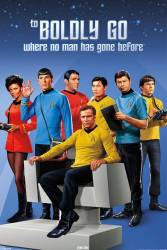Factual error: When Kirk is given the medicine badge, it's a stretchy elastic/Spandex headband. This is supposedly a completely pre-industrial culture paralleling the early Native American tribes. They have no fabric, no yarn, no spinning wheels - only hides and animal hair, neither of which can stretch a la Spandex. (00:14:40)
Is There in Truth No Beauty? - S3-E5
Factual error: The Enterprise accidentally travels a short distance outside the galaxy and can't find its way back. But they'd have to travel for months to get so far outside the Milky Way that they couldn't, well, just turn around in the void and see it. Our galaxy is huge. 100,000 light years across. Very huge. And that barrier may surround the galaxy, but even it is big, pink and visible.
Factual error: Throughout the episode, there is a constant reference to 5 p.m. being the time Kirk and crew (a.k.a., the Clanton gang) were to die. However, the real 30-second shootout was at 3 p.m.
Factual error: Spock says the Klingon ship is approaching at Warp Six, but Sulu counts off the distance at about 50,000 kilometers per second - that isn't even the speed of light.
Requiem for Methuselah - S3-E19
Factual error: Spock plays a piece on a harpsichord that he says is by Brahms, but Brahms was a late romantic composer and the piece is a simple baroque dance piece. Also by the time of Brahms the harpsichord was already obsolete, a composition like this wouldn't be sitting on a harpsichord.
Suggested correction: The first sentence is logical; if Spock is able to recognize the style as Brahms, then it should not possess the style and structure of Baroque music. The second sentence is not necessarily true because some romantic composers did write for the harpsichord. For instance, the late romantic composer Richard Strauss composed, "Divertimento for Chamber Orchestra after Keyboard Pieces by Couperin", which is scored with a harpsichord part.





